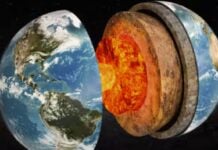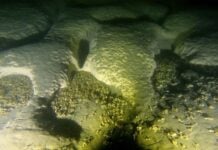Researchers working on the ROSETTA-Ice Project have discovered an ancient rock formation underneath Antarctica’s Ross Ice Shelf, the world’s largest sheet of ice.
Using the IcePod system, the team collected images of the ice as well as measurements of the magnetic field and gravity of what lies beneath. And a complex melting pattern emerged.

Using IcePod was a necessity. The Ross Ice Shelf is so thick that traditional ship-based methods wouldn’t work. As reported in the new publication, an area halfway through the ice shelf suddenly drove IcePod’s magnetic field measurements wild. The researchers discovered a previously unmapped segment of the geological boundary between East and West Antarctica.
The team then used gravity field measurements to model the shape of the seabed beneath the ice shelf. It soon became clear that the boundary has a profound effect on the overlying ice shelf, which is roughly the size of Spain.
“We could see that the geological boundary was making the seafloor on the East Antarctic side much deeper than the West, and that affects the way the ocean water circulates under the ice shelf,” lead author Kirsty Tinto, the Columbia University research scientist who led all three field expeditions, said.
Ocean currents affect the rate of thawing of the ice above, which can and will impact the entire planet. The Ross Ice Shelf helps slow down the flow of about one-fifth of the ice that rests on the southernmost continent. If all of that ice were to melt and end up in the ocean, we would be looking at a global sea level rise of over 11 meters (38 feet).
The team used computer simulations to work out how the newly discovered geology affects underwater currents. Little warm water reaches the ice shelf but cold water currents can reach the deeper portions of East Antarctica’s glaciers, causing them to melt. These currents are stopped by the newly discovered boundary, so West Antarctica’s glaciers are safe for now. A more worrying discovery is that the front of the Ice Shelf is at risk.
“We found that the ice loss from the Ross Ice Shelf and flow of the adjoining grounded ice are sensitive to changes in processes along the ice front, such as increased summer warming if sea ice or clouds decrease,” said Laurie Padman, a co-author and senior scientist at Earth and Space Research.
Antarctica as we know it will disappear… helped by water but also volcanic activity.










